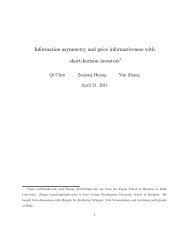Does Enforcement of Intellectual Property Rights Matter in China ...
Does Enforcement of Intellectual Property Rights Matter in China ...
Does Enforcement of Intellectual Property Rights Matter in China ...
Create successful ePaper yourself
Turn your PDF publications into a flip-book with our unique Google optimized e-Paper software.
ights enforcement on f<strong>in</strong>anc<strong>in</strong>g, R&D <strong>in</strong>put, and R&D output. The evidence suggests that<br />
facilitat<strong>in</strong>g f<strong>in</strong>anc<strong>in</strong>g and <strong>in</strong>vest<strong>in</strong>g <strong>in</strong> R&D are the channels through which better IP rights<br />
enforcement could affect, <strong>in</strong> the aggregate, the growth <strong>of</strong> the economy.<br />
4.1 The effect <strong>of</strong> IP rights enforcement on f<strong>in</strong>anc<strong>in</strong>g<br />
4.1.1 Access to new debt<br />
We exam<strong>in</strong>e the relationship between prov<strong>in</strong>cial-level IP rights enforcement and the <strong>in</strong>dividual<br />
firms’ ability to obta<strong>in</strong> external debt. We use a probit regression model for our 23,955 firm-year<br />
observations. To control for other factors that may affect these firms’ ability to obta<strong>in</strong> external debt,<br />
we <strong>in</strong>clude firm- and prov<strong>in</strong>cial-level characteristics. The model is specified as the follow<strong>in</strong>g:<br />
Y = α + β IP <strong>Rights</strong> <strong>Enforcement</strong> + β Firm Variables + β Prov<strong>in</strong>cial Variables<br />
i,t 1 i,t-1 2 i,t-1 3 i,t-1<br />
+ β Industry Dummies + ε<br />
5 i i,t<br />
(1)<br />
The dependent variable,<br />
Y<br />
i , t<br />
, is one if the net <strong>in</strong>crease <strong>in</strong> debt is at least 5% <strong>of</strong> total assets <strong>in</strong> year t,<br />
and zero otherwise. The set <strong>of</strong> firm-level variables <strong>in</strong>clude: patent dummy (which is coded as 1 if<br />
the company has any patents before the current year and 0 otherwise), R&D <strong>in</strong>tensity, sales growth<br />
rate, <strong>in</strong>tangible to total assets, return on assets (ROA), leverage, natural logarithm <strong>of</strong> total assets, and<br />
natural logarithm <strong>of</strong> firm age. The def<strong>in</strong>itions <strong>of</strong> these firm characteristics are listed <strong>in</strong> Appendix 3.<br />
We also <strong>in</strong>clude prov<strong>in</strong>cial bank<strong>in</strong>g system development and corruption control, prov<strong>in</strong>cial GDP<br />
growth, the number <strong>of</strong> universities <strong>in</strong> a prov<strong>in</strong>ce, as well as the metropolis dummy. All <strong>in</strong>dependent<br />
variables <strong>in</strong> the regression model are lagged by one year. We also add 21 <strong>in</strong>dustrial dummy variables<br />
accord<strong>in</strong>g to Industry Classification Standard <strong>of</strong> CSRC. The standard errors are corrected for<br />
heteroskedasticity and with<strong>in</strong>-prov<strong>in</strong>ce correlations.<br />
Insert Table 2<br />
Table 2 (Columns 1 and 2) reports the probit estimates <strong>of</strong> the marg<strong>in</strong>al effect <strong>of</strong> IPP1 (the<br />
21



